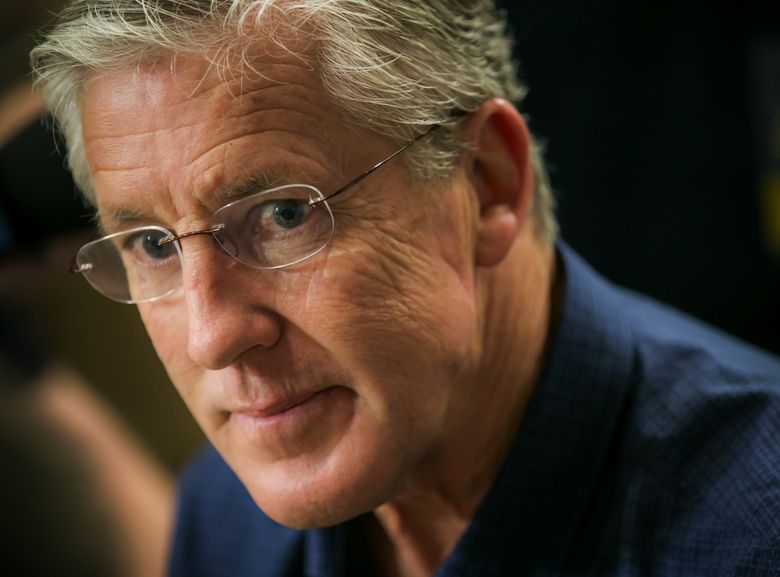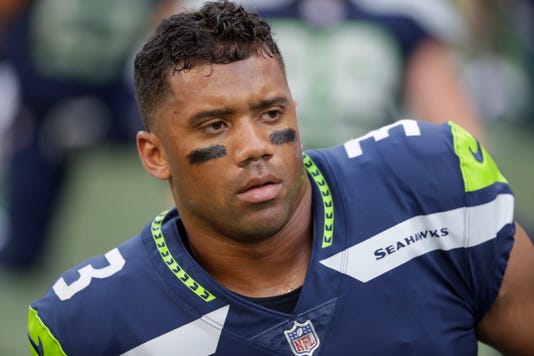/cdn.vox-cdn.com/uploads/chorus_image/image/62866666/usa_today_11376222.0.jpg)
Ben Banogu does a good job working in space
Thoughts on Ben Banogu
It was a little surprising recently to see Tony Pauline suggest Banogu could be drafted in the #40-60 range. Although he had an outstanding combine, he really isn’t much of an edge rusher at all. He lacks technique or any kind of repertoire. A lot of his best plays are incidental (he makes the right choice, an opponent runs in his direction). There’s barely any evidence of any hand placement, speed-to-power conversion or dynamic speed off the edge.
He looks more like a linebacker convert than a productive defensive end or LEO.
Banogu’s a massive project. He’s the very definition of an athlete rather than a football player. He’ll need time and major work to become a sack artist. With so many other DE’s in this class it’s hard to imagine him going as early as round two.
There is one aspect of his game I want to highlight though…
The Seahawks face the Rams twice a year. Los Angeles runs a bunch of sweeps, end-arounds and misdirection. Seattle’s somewhat conventional defense sometimes struggles to come to terms with this. New England shut down the Rams by playing safeties off the edge in space to try and combat the trickery they use and it worked a treat. We’ll see if teams cotton on to that gameplan in 2019 (and it might be one reason why the Seahawks are meeting with so many safeties — to have the option to play multiple safety looks against these high-powered offensive teams).
Banogu excels when he’s playing off the edge then reading and reacting. He’s exceptionally quick to cover ground, can sprint to the sideline and shut down any stretch plays and sweeps surprisingly well for a man his size. Time and time again you watch him cover one half of the field simply playing off the edge in space. It should be an ideal 1v1 matchup for a smaller running back or receiver against a 250lbs defender. Not against Banogu. He plays with great discipline to let the play develop then quickly reacts and makes a tackle. Not many players can do this.
This is one of the reasons why he might be better off working as a linebacker at the next level or at the very least a SAM/LEO.
You’re not likely going to take him in round two just for this one positive. He’s so raw as a pass rusher — he’d need to show more in that sense to warrant a top-60 grade. He could be a useful weapon vs the Rams however. Especially if you’ve got Banogu on one side and some extra safety help on the other.
Seahawks setting up a D-line draft
Whether it ends up being their first pick or not, the Seahawks are clearly setting up for a heavy D-line draft. That’s no surprise given the class. Yet they’ve been completely inactive in free agency. They’ve lost one player (Shamar Stephen) and shown no sign of wanting to keep another (Dion Jordan). They met with Nick Perry and a couple of defensive tackles. Anyone who signs at this stage isn’t a lock to make the roster.
Considering the pass rush and run defense both need help — we could see as many as three picks spent on the defensive line in this draft. They need a Tony McDaniel type or at least a strong, early down defensive tackle to rotate in and help against the run. Armon Watts at Arkansas has the anchor, length and size to adapt to this role (with some ability to rush the passer too). Albert Huggins is extremely powerful. Those are two examples of possible day-three run-defense targets.
In terms of the pass rush — Trysten Hill is too athletic to last too long and presents an opportunity to get an athlete with as much upside as the top-15 prospects albeit at a cheaper cost (although many regard him now as a sure-fire second rounder). Daniel Wise is a smaller, really disruptive pass rusher who impacts games. He could be brought in as a specialist three-technique. They could roll the dice on Ben Banogu or Justin Hollins’ athletic profile. Or they could spend their first pick on a dynamic inside/out type who can provide a perfect partner across from Frank Clark. There are a cluster of attractive five-technique or inside/out rushers.
Either way — their total lack of D-line additions so far is an enormous nod towards their draft intentions. They’re going to stock up on defensive linemen one way or another.
Why the Seahawks probably won’t trade Frank Clark before the draft
Ever since Jay Glazer tweeted teams were calling about Clark (including the Bills, who later disputed the report), there’s been a lingering thought that he might be dealt. A deal doesn’t seem close at the moment. With four key players out of contract next year (Clark, Russell Wilson, Bobby Wagner, Jarran Reed) — something has to give. Losing Clark for a 2021 compensatory pick wouldn’t be good value if he reaches free agency next year and leaves Seattle.
However, I don’t think a trade before the draft is likely. Here’s why…
I don’t believe the Seahawks have any intention of losing any of their ‘big four’. Pete Carroll feels they have a competitive roster and a new core. I suspect they will exhaust all possibilities to keep their key players before even thinking about a trade. They are still a long way off having exhausted anything with Clark.
He has until mid-July to sign his franchise tag or opt to hold out. That is a reasonable deadline for both parties. Seattle can make its best offer just before July 15th and apply some pressure. They can put Clark in a position to choose guaranteed wealth and security vs gambling on reaching the market fully healthy and off the back of a great 2019 season. Faced with a ticking clock, it’s hard to turn down guaranteed cash.
In order to create this environment for a deal, however, they need that July 15th deadline. You might say — why not just set a pre-draft deadline? Clark and his agent would reject it. As far as they’re concerned if the Seahawks trade him, they’ll be trading him to a team willing to give him a massive new contract. So actually this would accelerate the process for Clark and he’d be better off financially to be traded pre-draft. The Seahawks setting an April deadline doesn’t come with any consequences or pressure for Clark.
If the team felt an extension was impossible or highly unlikely he probably would’ve been traded by now. Instead it seems like they’re willing to let this process play out, create a realistic deadline from which all parties can reasonably come together and work towards a deal.
If a trade is going to happen now it’ll probably be heading into camp. If Clark doesn’t sign an extension and refuses to play on the franchise tag, the Seahawks might end up dealing him before the season rather than enduring any drama in camp while facing the prospect of losing him for very little in the way of compensation. However — right now we just don’t know how likely that situation is. My gut feeling is Clark wants to stay in Seattle and if the Seahawks make a fair offer in July — he’ll likely agree terms to remain with the team rather than risk playing on the tag.
As with the Wilson negotiations — patience and time is probably the key factor.
A trade scenario that makes sense
The Seahawks need picks so trading down twice to fill out their board is more likely than not. Here’s a trade scenario I might use for the next seven-round projection.
Note — all trade value data came from this chart.
The Seahawks trade #21 to Kansas City for #29, #93, #167 & #214
The Chiefs seriously need to consider drafting a wide receiver given the recent news on Tyreek Hill. D.K. Metcalf’s sensational forty yard dash and ability to run a great go-route makes him an ideal fit with Patrick Mahomes. Parris Campbell’s 4.31 speed and Marquise Brown’s electricity could also appeal. The Ravens are reportedly after a receiver so Seattle’s pick at #21 could become a target for a team like the Chiefs.
According to the chart the value of pick #21 is 261 trade points. Kansas City’s four picks add up to 256 points:
Seahawks — #21 (261)
Chiefs — #29 (203), #93 (42), #167 (8), #214 (3)
The Seahawks trade #29 to Buffalo for #40, #112 & #131
If the Bills draft an offensive tackle at #9 they’ll be keen not to miss out on the top receivers with their second pick. If the run starts at the end of round one — they’ll need to act. Funnily enough if the Seahawks trade out of #21 to allow another team to draft a wide out, they could kick start the run on the position — making it easier to trade down for a second time. In this scenario the Bills move up for Marquise Brown — jumping ahead of the Green Bay Packers (also in the receiver market).
According to the chart the value of pick #29 is 203 trade points. Buffalo’s three picks add up to 192 points:
Seahawks — #29 (203)
Bills — #40 (149), #112 (26), #131 (17)
In both cases the Seahawks give up some value. They might have to this year with great depth in rounds 2-4 and only a few ‘legit’ first round prospects.
These two trades leave the Seahawks with nine picks. They have to move down 19 places to get from four to nine but that might be an inevitable compromise in order to have a proper draft this year.
You can now support Seahawks Draft Blog via Patreon by clicking the tab below.





/cdn.vox-cdn.com/uploads/chorus_image/image/62824988/usa_today_10350171.0.jpg)
